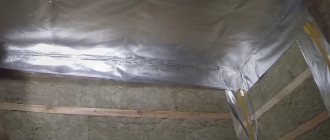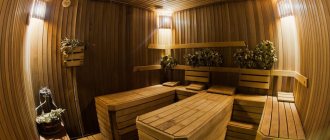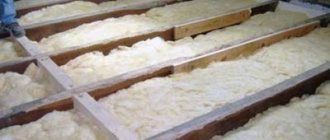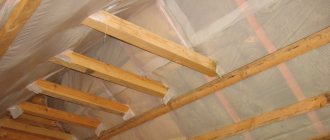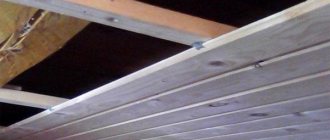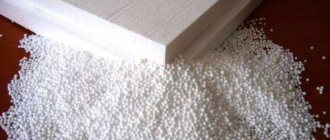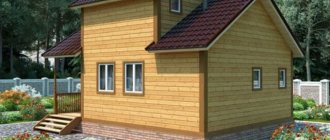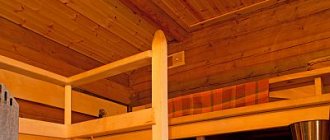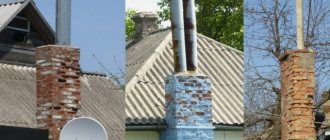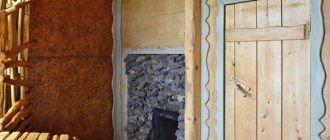Interior decoration of a bathhouse - what is used besides lining?
Bath buildings are built from logs, concrete and cinder blocks, bricks and other building materials. The lining of the interior with clapboard remains unchanged. In this article we will tell you what other finishing and decorative products can be used in a bathhouse.
In addition to lining, what can you use to cover bathhouse buildings?
The choice of finish depends on the purpose of the room. Inside the building, in addition to the steam room, there is a relaxation room, an entrance hall (dressing room), a bathroom or a washing room. If desired, the project includes a terrace, a residential attic, or several square meters for a small pool.
Lining is a universal material; with proper processing, it can cover all walls and ceilings, but it will turn out too monotonous. Therefore, diverse interior decoration of the bathhouse is chosen.
Already from the name it is clear that this room is periodically maintained at 100% humidity and high temperature. We need a finishing material that can withstand such changes and also does not emit substances harmful to humans during heating: formaldehyde, ammonia, phenol and others.
- According to the specified parameters, only solid wood is suitable, so the owners always try to line the inside of the bathhouse with clapboard made of linden, aspen, cedar, and abasha (African oak). Often planed products from larch or pine are used, but in this case it is necessary to choose slow-growing varieties, since so-called resin pockets do not form in them. Accordingly, the resin will not constantly be released on the surface.
- The bathhouse, in addition to lining, can be finished with more budget-friendly options - edged or unedged boards made of various types of wood - linden, cedar, alder, aspen. Only untreated wood will need to be pre-prepared for installation - remove the bark and sapwood, sand it and coat it with wood-protective water-based varnishes or impregnations with a biocidal effect.
- Covering the walls inside a brick bathhouse with planed boards gives a much better heat-intensive effect, since the thickness of the molded products exceeds the section of the lining by 1.5-3 times.
- Do not try to cover the steam room and other rooms with sheets of sawdust: plywood, chipboard, OSB and other analogues, even moisture-resistant ones. During the heating process, thermosetting resins containing sawdust begin to emit toxic fumes. The result is poisoning of the body instead of healing.
- For the ceiling, in addition to lining or edged boards, designers offer a non-standard option - tempered frosted glass, under which lighting is mounted. The bathhouse will turn out to be very unusual, but modern.
- The floor can be covered with clinker or heat-resistant ceramic floor tiles with a special anti-slip coating. It is hygienic and will withstand high temperatures perfectly.
- And lastly: if the bathhouse is made of rounded or profiled logs, then the finishing technology inside the building does not require covering the ceiling and walls with anything. It is enough to treat all surfaces with fire-retardant compounds on a water or oil-wax basis with a moisture-resistant effect.
- A bathhouse without a washing station is unthinkable. Invariably, the best material for bathrooms and toilets are ceramic products: tiles, mosaics, porcelain stoneware. This is convenient and inexpensive, since you not only need to cover it with clapboard, but also take care of its safety. That is, constantly treat the lining with protective agents with a moisture-resistant and biocidal effect. Tiles don't need this.
- The walls and ceiling are finished with decorative waterproof plaster, plastic panels or plasterboard or glass magnesite for painting with waterproof compounds, but only if the steam room is thermally insulated according to all the rules.
- But for the floor in the bathroom, the choice of products is more extensive. Traditionally, floor tiles or porcelain stoneware are used, but you can cover a small room with modern waterproof laminate made of composite plastic (Duma Floor, Aqua-Step) or special moisture-resistant floor panels, which are offered by the most famous manufacturers of laminated flooring - Egger, Quick Step, Alloc and others.
- By definition, it is intended for changing clothes and precedes the entrance to the steam room. To set the mood in the appropriate manner, they also try to cover this unique vestibule with clapboard, but here you should not limit yourself to finishing options.
- A multifunctional bathhouse is an excellent field for applying your imagination in the field of design. You can cover the walls with decorative clinker or ceramic tiles to imitate stone or brick, wallpaper, including fiberglass, paint them in any color, apply decorative plaster, or cover them with plastic or veneer planks.
- The floor in the intermediate room requires a more or less moisture-resistant material - PVC linoleum or natural marmoleum, vinyl or ceramic tiles, porcelain tiles, edged boards and even plywood or chipboard for varnish.
- The ceiling inside the dressing room, in addition to the lining, can be sheathed with panels or simply painted. Ceiling wallpaper on a non-woven or fiberglass base will look good.
4. Rest room.
- The good thing about a bathhouse is that, in addition to everything else, it almost always has a room for relaxation. To create a special mood, use laminate and MDF or PVC panels with wood decor, vinyl or quartz vinyl tiles, and wallpaper with a corresponding pattern.
- Some paint and varnish manufacturers offer special mixtures that allow you to imitate wood on any mineral or old wooden surfaces. For example, the Dulux series has two-component Trade BrushWood paint. A bathhouse made of bricks or concrete blocks is first lined with sheets of SML, gypsum board, OSB, then a composition is applied over the puttied and primed surface, which, after drying, creates a wood texture that is visually almost indistinguishable from natural.
Lining - pros and cons
Summarizing the above, it is worth noting that a bathhouse cannot do without lining. This is the best finishing material, as it has a unique set of positive properties:
- Low thermal conductivity and high heat capacity.
- Resistance to temperature and humidity changes.
- Resistance to splitting.
- Optimal noise reduction ratio.
- Pleasant, healing smell.
- Easy to install.
Among the disadvantages, it is worth noting that the lining is susceptible to rotting and woodworms, but the problem can be solved - it is enough to treat the surface with special protective compounds for baths and saunas in order to forget about problems with wood for 3-5 years.
Below, watch a useful video about what materials can be used to cover a bathhouse.
Choosing wood for finishing
Not all tree species are suitable for interior decoration of a bathhouse.
The most suitable are:
- Linden is the best tree for a steam room. It is suitable for lining a steam room and for making shelves. This wood does not darken and retains its aesthetic appearance for a long time, does not contain resins, does not heat up, emits a pleasant aroma and does not cause allergic reactions.
- Aspen . The characteristics of this wood are similar to those of linden. However, it costs even more than linden lining.
- Cedar . An excellent type of wood for finishing a bath. Cedar lining has a long service life, low thermal conductivity, does not emit resin, smells very pleasant and has healing properties.
- Oak _ This tree can withstand high temperatures and humidity, is very strong and durable. A peculiarity of oak is the change in color, but this will not at all spoil the appearance of the interior decoration of the bathhouse. The only drawback of oak lining is its higher cost compared to many other types of wood.
It is not recommended to use coniferous lining for finishing a steam room in a bathhouse.
Despite the attractive price, good characteristics and healing aroma, coniferous wood can become dangerous. This is due to the fact that when heated, the lining made of spruce or pine begins to release resin, which can cause burns.
Bathroom trim
What material is suitable for tiling a bathroom or sink - tiles or porcelain stoneware. Unlike wood, ceramics will not require constant treatment with moisture-protective and bactericidal agents.
Glass-magnesite boards are no less popular. This is a durable, moisture-resistant, non-flammable, non-toxic material that is not susceptible to the development of fungus or mold.
You can also use decorative moisture-resistant plaster, plastic panels, plasterboard and glass magnesite for walls and ceilings, followed by the application of waterproof solutions. PVC, slatted pebbles and fiberboard are also allowed. However, it is necessary to take care of complete thermal insulation of the steam room.
In addition to tiles, you can lay moisture-resistant laminate or panels based on composite plastic on the floor. But tiles will be more practical and durable. Wooden shields are placed on top of it to prevent slipping. What interior to create in the washing room in the photo below.
DIY finishing process
A day before the start of work, it is recommended to bring into the bathhouse all the materials that will be used in the finishing process. This must be done so that the material “acclimatizes” to the room temperature.
Highlights of interior finishing step by step:
- Manufacturing of sheathing;
- Fastening steam and thermal insulation;
- Installation of wooden panels.
You don’t have to limit yourself to just a bathhouse, but also decorate the walls of your home with clapboard. Read how to do this here.
Requirements for installing sheathing
- The sheathing slats must be positioned strictly parallel to each other and the floor. To achieve this, a level is used.
- First, the upper and lower guides are attached, and then all the other slats.
- It is necessary to place the slats from each other at a distance of no more than fifty centimeters.
- The finished frame must be treated with an antiseptic.
Hydro- and thermal insulation of steam room walls
For vapor barriers , aluminum foil and foamed polymer materials (polypropylene) are most often used. The advantage of polymer materials is that they simultaneously have vapor and heat insulating qualities.
These materials, laminated with foil, not only help maintain a high temperature in the steam room, but also resist the accumulation of dampness and the appearance of fungus .
- Attach insulation to the timber wall (mineral wool is best suited for this purpose).
- Attach a layer of foil to the insulation.
- Install the sheathing (it is necessary to create an air gap between the lining and the foil layer).
Installation of lining
A more suitable and more modern means are clamps - staples, which, when installed, do not damage the surface of the lining, since they do not form holes in it. This is the so-called hidden fastener.
You should know that there are different types of clamps, depending on what materials they are intended for fastening.
Walls should be sheathed vertically.
This is due to the fact that condensation that can form on the walls will flow down, rather than accumulating at the joints and gradually ruining their condition and appearance.
For a step-by-step guide on how to properly cover walls and ceilings with clapboard, watch the video instructions:
Arrangement of the rest room
The main thing here is not practicality, but comfort, a relaxing atmosphere, and ergonomic design. The most affordable way is to sheathe the room with pine boards. They do not rot, dry quickly, and look beautiful. Based on the durability of the material, it is better to choose boards made from Scandinavian pine. A pleasant light pink shade will eventually become covered with an original patina and will give the room even more coziness.
Spruce lining can also be classified as an inexpensive and high-quality finishing material. Thanks to Swedish and Finnish hot air processing technologies, the boards acquire the necessary strength and moisture resistance. There is less resin in spruce than in pine, it is more fragrant, and small knots (which are inevitable) easily turn into the individuality of the interior.
Budget materials for a relaxation room also include laminated, polyvinyl chloride MDF panels, quartz vinyl tiles, fiberglass wallpaper, decorative plaster, tiles with a stone, brick or wood pattern. In general, everything will depend on the imagination of the owners and the style in which the room is intended to be decorated.
There are also compositions (two-component paints) that completely imitate wood on any surface (mineral, old wood). The inside of a brick or concrete-block bathhouse is finished with OSB or gypsum board panels, primed and puttied. Then paint is applied.
Since there is no increased temperature and humidity in the recreation room, linoleum flooring, tiles, edged boards or chipboard followed by varnishing can be used for the floors.
It is cheaper to stick fiberglass wallpaper on the ceiling or simply cover it with paintable panels.
But, if you still want to make a bathhouse not only a place of relaxation, but also a place of healing, the use of wood cannot be avoided. You simply select varieties of inexpensive wood: birch, alder, poplar, aspen, pine. And for areas with increased workload, you can use oak, cedar and linden.
If the bathhouse will be in use all year round, it is better to install heated floors in the relaxation room, and the walls should be well thermally insulated before covering.
Flat ceiling
By the way, if during the construction of the roof it is planned to use vapor permeability membranes under the roof layer, then their use in the installation of the ceiling is not necessary - the roof membrane will take over the role.
A compromise version of the ceiling, combining a floor and hemming scheme. From the false ceiling, it has beams/beams on both sides and the possibility of later building a second floor over the bathhouse. And from the flooring - the ease of assembly, although it is not carried out in place, but on the ground, that is, the panels are knocked together, which are then lifted and fastened one after another.
1. Beams with a cross-section of approximately 50 x 100 or 60 x 110 mm are laid on a flat surface, at a distance of 50 cm from one another in parallel.
3. After all the dies have been stuffed onto the beams, the shield is turned over with the beams up, and the steam and waterproofing is stapled over the entire surface.
4. If there is no lift, then such a shield can easily be lifted and secured to the wall consoles on top by two people. And first, insulation is laid between the beams covered with a membrane, hammering it tightly so that it does not dangle.
5. The panels are installed one by one on the upper plane of the wall crown. Or in a groove specially cut for this purpose. Or these panels rest on a beam securely nailed along the perimeter of the walls.
| At the junction of the shield and the crown, you also need to lay an insulating seal. This can be done using felt-jute tape. |
8. From below, inside the bathhouse, the ceiling, if it is made of rough boards, is lined with clapboard.
How to treat the surface → Room decoration → How to choose the right paint → Surface treatment technologies → Leveling and finishing the walls → Selecting and applying a primer → Removal from the surface → Stretch ceilings and technologies → Reviews and testimonials
Advantages of a panel ceiling
- Both the main assembly and insulation operations (with the exception of small details) are done below, on the ground.
- The strength of the ceiling will allow you to build a second floor of any size - as long as the strength of the walls and foundation is designed for this.
- It is possible to install ceilings over rooms up to 3 meters in size on any side.
- Large volume of small works.
- You need lifts or the involvement of two or more people (ideally, at least three).
- The need for full-scale installation BEFORE installing rafters and roof decking - which is critical in unexpectedly rainy weather.
| To attach the ceiling board from below to the beams, it is better to use self-tapping screws rather than nails, because the impact of a hammer will not have the best effect on the places where the beams are attached to the supporting walls, as well as on the thermal insulation placed in the fastening sockets. |
How to insulate the ceiling in a bathhouse and how to cover it correctly: do-it-yourself insulation and insulation - which thermal insulation is better
It’s good when you have the opportunity in the warehouse to check whether the lining has moved; to do this, you need to join two planks; if this happens freely and without gaps, then everything is fine.
Expert opinion
Strebizh Viktor Fedorovich, leading construction foreman
When fixing the planks through the front part, the caps are visible, but the fastening is reliable, the fixation through a tenon or groove is invisible, but a small part of the board is captured, so when the lining expands, there is a possibility that it will be turned out or torn off. If you want to clarify something, please contact me!
Why spend money on lining, if you can partially decorate the bathhouse with MDF panels. Personal experience.
In several articles on my channel there was a photo of a flight of stairs in my house, which I recently decorated with MDF panels. Under these articles, people immediately appeared who desperately began to write that in a year the panels would certainly begin to peel off and fall off, well, at least they would DEFINITELY swell. Such forecasts always amuse me; according to them, my house should have collapsed even at the foundation stage. But that's not what we're talking about here. Seven years ago we built a bathhouse for our parents. Frame bathhouse. Now fans of “proper” bathhouses better hold on to something - in addition to the fact that it is decorated with MDF panels, it is also insulated with foam plastic. True, not throughout the bathhouse, but only in the dressing room and in the gathering room.
How to insulate a log sauna from the outside
Almost all insulation of a log bath comes down to carefully sealing the cracks. Even during construction, a special jute insulation was laid between the crowns, but over time the wood dries out, cracks, and new cracks form, which need to be caulked regularly.
Insulation of a log bath
After erecting the frame and caulking the cracks, the building must remain under the roof for at least six months. It is advisable not to use the bathhouse during this time. The log house will shrink, the wood will dry out, and new cracks and gaps will appear. These are the ones that need to be caulked. For this purpose, a special insulation based on jute and flax is used. Jute itself conducts heat poorly and does not burn, but its disadvantage is low elasticity (it tears easily). To solve this problem, flax fibers are added to the insulation for log houses. Thin strips of material are driven into the cracks using a hammer and a special metal caulking blade. This must be done carefully to prevent distortion of the structure.
There is also a special sealant for sealing cracks in wooden buildings. It’s easier to work with: a special syringe fills all available voids.
Insulating a log bath using sealant
A log house shrinks within two years. At this time, it is not recommended to cover it with finishing materials. This way you will have access to newly appearing cracks that need to be periodically sealed from the inside and outside. To protect the insulation from the effects of precipitation, the outside of the building can be covered with film, securing it with strips.
Two years after construction, you can begin finishing. For many this will sound ridiculous, but structures made of logs can be sheathed with a block house, clapboard, imitation timber, or dies. To begin with, a sheathing is mounted on the wall (if it is made of wood, it must be treated with antibacterial impregnations and increases resistance to fire), which is checked for verticality and horizontality using a building level.
Lathing for insulation and finishing
Finishing material is attached to the sheathing, which is then coated with varnish or other protective compounds. If you choose metal guides, they are mounted on special hangers.
Insulation on the outside of a log bath is almost never used, and the inside is only sometimes additionally insulated in the steam room and washing room. If you decide to play it safe and insulate the building, if the insulation is afraid of moisture, a vapor or water barrier is laid on top of it. It is secured using strips, onto which the trim is subsequently attached.
Brief description of the bathhouse itself.
The dimensions of the entire building are 3.5 by 9 meters. It is divided into 2 halves. The first is a gazebo, which is used for gatherings, including in winter. It is not insulated, but when the bathhouse is heated, the door opens for heat, the gas stove lights up and the room is relatively warm. I am writing this to make it clear that condensation from the bathhouse is in full swing at this moment. The second part is the dressing room/dressing room and the washing room itself with a steam room. The dressing room is lined with MDF panels, and there is no ventilation in it - it is planned, but not everyone gets around to it. In winter, the bathhouse is used once or twice a week. Almost every day in the summer.
Calculation of ceiling heights for steam rooms
The dimensions of a bathhouse depend on the size of all its functional rooms: steam room, washing room, dressing room, relaxation room and technical areas. When calculating the distance from floor to ceiling, it is important to take into account the design and operational features of each room.
When designing the height of the steam room, the type of internal microclimate that is created in the process of heating the room is of great importance.
Pie microclimate
A distinctive feature of the microclimate is the accumulation of heated air masses and a vapor cloud under the ceiling. In this case, the minimum permissible distance from the visitor’s head to the ceiling surface should be 65 cm, the optimal – 85 cm. This will protect the head from overheating, but will allow you to easily reach hot steamed air with a broom.
If there is no elevation on the floor and the average height of a person is 180 cm, the permissible distance from floor to ceiling is in the range from 235 to 260 cm.
Conditioned microclimate
In a steam room with a conditioned microclimate, it is important to organize a free amplitude of swinging a broom when carrying out health procedures. What should be the height of the steam room in this case? The optimal height range is from 210 to 225 cm.
To prevent possible steam leakage when using the bathhouse in winter, the door length should be 160 cm, which is quite inconvenient for tall people. To solve this problem, it is necessary to raise the ceiling to 240 cm and install an additional platform for carrying out procedures.
The minimum permissible distance from the top shelf to the ceiling should be 120 cm to ensure a comfortable swing of the broom. The shelves are installed in several tiers in accordance with the overall dimensions of the room.
Is it possible to use MDF panels in damp rooms?
As personal experience shows, the panels in the dressing room have not changed at all in 7 years, although the room there is certainly damp. The joints are not heaving, there are no visible damages. The MDF panel is completely ordinary, at one time purchased on sale at the nearest construction supermarket. In winter, there is a lot of condensation in the bathhouse after washing, and it is not always dried immediately. It is also necessary to take into account that the panels cross Zero at least 2 times a week in winter. To complete the picture, the panels are secured with a ventilation gap using self-tapping screws. (9 mm self-tapping screw with press washer). There are no unnecessary smells in the dressing room either. It smells like a bathhouse and brooms. So the answer to the question - can it be used - is definitely possible.
In the background is my flight of stairs. In the front is my wife, who seems to be hinting to you: “You need to LIKE!”
What materials should not be used
A bathhouse is a building with a specific purpose. The aggressive environment will not allow the use of any material for cladding. Cladding boards and panels made from pressed wood waste are not suitable for every room. The slightest moisture causes them to become deformed. Combustible materials cannot be used as insulation. Polystyrene foam and expanded polystyrene are only suitable for insulating the floor of a dressing room or washing room, but it is advisable to fill it with a concrete screed.
PET film and roofing felt are not used when lining the bathhouse. The material can be laid instead of waterproofing the ceiling on the side of the cold attic. However, it is better to cover the area above the steam room with a heat-resistant membrane.
Wooden lining that shows signs of mold should not be used for cladding. In a humid environment, the fungus will quickly spread throughout all structural elements. An unpleasant smell of rot will appear inside the bathhouse. The ceiling will quickly collapse.
Attention! It is unacceptable to use polyurethane foam inside the steam room to seal joints and seal cracks.
We suggest you familiarize yourself with: Stone wool insulation dimensions
P/S from the author.
Is it possible to use MDF to decorate a bathhouse - as for me, it’s so easy, besides, now they are just like wood. I’m not taking this out of thin air, but from personal experience in using such a bathhouse. It's all about saving. This bathhouse cost about 100 thousand rubles for everything. And we must take into account that this is a fairly large building. For those who are interested in the estimate and what was built and how, read the article; for those who are interested in the topic of economical construction, subscribe to “Samostroy”
, the girl below in the photo recommends it to you)))):
Near the stove
It’s clear how to cover the ceiling with clapboard in a bathhouse, but what about the space near the chimney? The decoration near the bathhouse stove on the ceiling should differ from the main one. Wooden lining is not suitable for finishing it, because it is susceptible to burning. The place where the pipe comes into contact with the ceiling must be additionally protected with non-flammable material and covered with a metal apron. How to cover the ceiling in a bathhouse? The following can be used as protective fibrous material:
- Basalt or stone wool;
- Asbestos is a fire-resistant material in sheets;
- Minerite is a non-combustible slab that is produced specifically for insulating stoves.
On the outside of the ceiling, the outlet of the chimney must also be insulated with non-combustible material, regardless of the thermal insulation material.
How to line the inside of a bathhouse?
Sheathing is the most important event, after the actual construction, when building a bathhouse. Here you should pay special attention to the materials with which you are going to cover the bathhouse, as well as special processing compounds that will preserve the appearance of the steam room for a long time. How to insulate a bathhouse? The choice of insulation begins with determining the basic properties that the material should have. Firstly, the material must be non-flammable; comments are unnecessary here. Secondly, the material must be steam and water resistant to retain heat inside the steam room. Finally, the material must be environmentally friendly to preserve your health.
Based on these considerations, the following combination can serve as a very good insulation: basalt wool with foil. Warming occurs in two stages. At the first stage, a wooden frame is installed, which is filled with cotton wool. To install the frame, it is best to use small bars with a cross section of 30*30 mm.
The bathhouse is lined with foil to retain heat
At the second stage, foil is sewn over the frame with basalt wool. It is best to use a pneumatic stapler to secure the foil. What materials are used to decorate a sauna? The traditional material for finishing a sauna is pine lining, however, it is better to use it for the dressing room; for the steam room itself, it is better to purchase alder or linden, which do not release resin during the heating process. With proper treatment, such materials can last a very long time.
Lately, imitation timber has become popular. This type of finishing has a more presentable appearance and has a number of other advantages, including ease of installation, as well as resistance to deformation and cracks. When using such material, you get the feeling that the room is made of solid timber due to the wood pattern.
It is better to choose natural material for the bath
The main condition when choosing a finishing material is its naturalness. Synthetic materials, despite their low cost and beautiful appearance, have a number of disadvantages. Among them is poor air circulation, which will cause discomfort when visiting the sauna. It should be noted that many materials of this type are not fire resistant and/or may release harmful substances when heated. Therefore, the choice should be made towards wooden finishing materials. How to treat the steam room? The most difficult and controversial issue is the choice of means for treating the steam room. The steam room is treated to protect the interior from fungus and cracks.
On the other hand, there is a controversial opinion that when heated, the processing composition can release harmful substances that can harm health. Therefore, an important condition when choosing a treatment is its naturalness. The fewer chemical components, the better.
A water-based varnish may be a good option. After applying the varnish, you should dry the steam room thoroughly and only then can you use it. Any wax treatment can also be an excellent solution. This material is easily applied to the surface of the skin and reliably protects against the formation of fungus.
Finally, a no-treatment option should be considered. With this option, you should thoroughly ventilate and dry the steam room after visiting. If damaged areas are identified on the casing, replace them immediately. However, you don't have to worry about the risk of inhaling toxic emissions that may be in the process.
The editors of uznayvse.ru hope that these simple tips will be useful to you and invites you to read the article about sauna barrels.
Preliminary work
Immediately before starting to finish the ceiling in the bathhouse, it is necessary to carefully prepare the project in order to avoid mistakes or undesirable consequences in the future.
The ceiling in the bathhouse must meet several requirements:
- Serve as a heat insulator;
- Look beautiful;
- Do not release fumes that spoil the pleasure of going to the bathhouse;
- Have a long service life;
- Serve as protection against moisture for the thermal insulation layer.
Before arranging the ceiling, you also need to decide on its height. For most modern bath rooms, a height of about 2.5 m is ideal. For bath structures made of wood, a gap is also provided, since the material shrinks.
After this, you need to decide on the materials with which the ceiling will be finished, the necessary lighting and the method of installing the selected finish.
Sheathing the ceiling in a bathhouse should be done only after calculations have been made and the ceilings have been secured. The false ceiling in the bathhouse is the most common. It is a “layer cake” that is mounted on pre-installed joists. The basis is made up of tongue-and-groove boards fixed directly to the ceilings, followed by a heat-insulating layer followed by a vapor barrier. So how to properly hem the ceiling in a bathhouse?
The listed building materials are quite sufficient to ensure that the optimal temperature in the bathhouse is maintained for a long time. An additional room can be created from the attic by simply laying a layer of boards on top of the thermal insulation. They can be fixed to the same beams - the protective layer usually does not exceed them.
Before starting work, it is necessary to measure the room and add 5% to the result obtained. It is worth paying attention to the symmetry of the ceiling. If it is not ideal, you need to decide which wall the sheathing, cut at an angle, will be attached to. Usually this is done near the darkest wall so that it is not too noticeable. The rough ceiling in the bathhouse and the filing must be installed taking into account all the necessary requirements.
Required:
- roulette;
- ruler;
- putty;
- wooden slats and bars;
- building level;
- electric drill;
- screws.
To sheathe a ceiling with plywood, you need to have a fairly flat surface, since all the irregularities will stand out on the already installed material. Therefore, the potholes and cracks present on it must be repaired using putty. When installing, it is better to use sheets that are equal to the length of the room. This will give the future ceiling a more aesthetic and neat look.
Before work, its surface must be prepared. To do this, if necessary, the old coating is removed and cleaned of dust and dirt. Then a diagram is drawn up, on which the location of entire sheets is noted and the sizes of their cut pieces are determined. It is also necessary to calculate the order of installation of the sheathing.
Figure 1. Installation diagram of wooden sheathing.
Since the edges of the plywood must be screwed to the sheathing to avoid sagging, the location where the entire sheets will be located is first calculated. They are usually screwed in the center of the room, and cut-off elements are installed closer to its edges. After this, you need to determine the center of the ceiling using a tape measure.
It is necessary to install a wooden sheathing on the ceiling, onto which the plywood will subsequently be attached. For this, glued laminated timber with a cross section of 20x40 mm is used. First, horizontal slats are fixed to the ceiling surface with screws, then intermediate ones. When installing them, you need to maintain a distance of 40-50 cm between the sheathing elements to avoid sagging (Fig. 1).
How to line a bathhouse from the inside - how to choose material
The history of such a simple but necessary invention as a bathhouse goes back many years, but even today, this building practically does not lose its relevance. A shower and bath cannot completely replace a bathhouse, because in it you can not only get rid of dirt, but also improve your health. Usually a bathhouse consists of a dressing room, a sink and a steam room, but the last two points are often combined.
When building each of these rooms, it is necessary to decide how best to line the bathhouse from the inside, because the air temperature in the room will depend on this, as well as the amount of fuel needed to heat it. In this article we will talk about all the most popular and reliable options for lining the inside of a bathhouse.
Is it possible to sheathe the dressing room with plywood?
You can line the inside of the bathhouse with plywood, you need to varnish it on both sides. Here you need to clearly know the following: A bathhouse is a structure of several rooms, a steam room, a dressing room, showers, a relaxation room, different materials can be used, because the temperature and humidity in the room are not the same depending on the room.
Interesting materials:
Is it possible to transfer units from kcell to asset? Is it possible to move objects with the power of thought? Is it possible to move the kitchen into the living room? Is it possible to move the walls in the bathroom? Is it possible to replant trees in October? Is it possible to replant gooseberries in summer? Is it possible to replant flowers in January? Is it possible to replant thuja in the spring? Is it possible to rearrange a parrot's cage? Can I transfer to another college mid-semester?
Briefly about the purpose of the cladding
Don’t rush to think about how best to line the inside of the bathhouse, because lining may not be needed at all. The task of the internal lining of the bathhouse is to retain internal heat for a long period of time, which will significantly reduce fuel consumption and combustion time. Thus, we can conclude that the cladding is an integral part of the bathhouse, but this is not entirely true, because a bathhouse built from solid timber using old technologies does not need additional insulation (for more details: “Painting with paired clapboards - how to do it right”).
Having built a bathhouse from cheaper materials, you will have to think about choosing a cladding material.
First of all, you need to mention the main characteristics that the selected material should have:
- It must withstand high temperatures and be non-flammable;
- Steam and moisture resistance are also necessary indicators;
- It is advisable to choose natural materials without harmful chemical treatments, so as not to harm your health with harmful fumes.
Speaking specifically about what can be used to line the inside of a bathhouse, it is worth mentioning lining, block house and magnolite. Of the three options presented, choosing one can also be difficult, so below we will talk in detail about each of them.
Bath frame and lining
Start of construction of a frame bathhouse.
The main thing in the design is the frame. It is made from special boards that are treated with an antiseptic. The size of the boards is determined not only by considerations of strength, but also by the need to accurately adjust the insulation to them, which is placed between the frame racks.
Its thickness should not exceed the width of the board. Additional structural strength is provided by the internal and external cladding of the frame. The corner posts, as well as the upper and lower frame frames, must be made of timber or especially strong boards.
The lower trim must be fenced off from the foundation with roofing felt. Intermediate posts are installed at a pitch that is suitable for both laying thermal insulation and sheathing.
Calculation of the pitch of the racks must be especially careful. It is also necessary to take into account what the frame will be sheathed on the outside.
In addition to traditional plywood or lumber, OSB (oriented strand boards) and CSP (cement-bonded particleboard) boards are also used for this purpose. The width of the OSB sheet and the plywood sheet is 1.22 m, and the width of the DSP sheet is 1.25 m.
To ensure that the sheets are joined closely and there is no need to trim them, the intermediate posts are made in increments of 0.6 m. This step is also convenient for installing thermal insulation, because its standard width is approximately the same.
Bathhouse with backfill walls: a - general view; b - plan of the bathhouse; 1 - dressing room; 2 — steam room; 3 — stove-heater; 4 — hot water tank; 5 - support under the floor joist.
Therefore, the material will fit tightly between the posts, without gaps, which means it will support itself. In addition, this step is ideal for laying the roof: maintaining equal distances between elements helps to evenly distribute the load on the frame.
For most of the territory of Russia, the following scheme for installing walls in a frame bathhouse is suitable:
- internal lining made of clapboard or plywood;
- vapor barrier gasket;
- frame made of boards 50×150 every 60 cm;
- again a vapor barrier gasket;
- insulation;
- waterproofing;
- external finishing cladding.
Bath lining
Lining is the most popular material for covering a bathhouse, because it combines all the most necessary qualities: reliability, beauty and reasonable price.
The lining also has a number of useful properties:
- Lining allows you to save a large amount of fuel, reducing heat consumption;
- Behind it you can hide various communications, increasing the level of comfort indoors;
- The lining is resistant to moisture and steam; in addition, it is able to regulate the level of moisture in the steam room and allows the walls of the bath to “breathe”.
- Longevity and resistance to the formation of fungus and mold are also important properties that this material has.
Next we should talk about the correct choice of material. First of all, pay attention to the fact that the price for lining up to 1.5 m is slightly lower than for material from 2 m, so it’s worth choosing a short length. When installing a short lining, use a batten in the middle to avoid various difficulties (more details: “Which lining is best for a bathhouse - a review of materials for a bathhouse, dressing room and shower”).
Finishing with glass-magnesium sheets
Glass magnesite sheets are sometimes called glass magnesite or magnesite plate
GSM (glass-magnesium sheets or magnetite) is an artificial material that is obtained by adding various binding components to fiberglass and finely dispersed wood shavings.
- resistance to moisture and mold;
- fire resistance;
- strength;
- light weight;
- no additional processing;
- flexibility;
- durability.
- fragility;
- high hygroscopicity (the ability to absorb water from air and steam);
- not environmentally friendly.
To decorate walls with glass-magnesium sheets, anchor fastening is most often used. Magnelite is great for wall decoration, but accessories, shelves and beds in the steam room are best made from traditional wood.
Block house for a bathhouse
If you cannot decide what to cover the inside of the steam room with besides the lining, then think about the block house, because it has similar qualities, but a different appearance. The block house has a semi-oval shape, so walls made of this material look like a log house, which gives “historical naturalness” to your bathhouse. The strength and resistance to various influences of the block house are quite high, however, it is recommended to carry out bactericidal treatment once a year.
Block houses are classified by quality:
- Class “C” material
undergoes only surface treatment; various defects may be present on its surface, for example, cracks or chips. This material is not recommended for installation in a bathhouse; - A class “B” block house
is of average quality and is extremely rarely used for finishing a bathhouse. There may be small cracks and knots no more than 3 cm on its surface; - On the surface of class “A” material
you will not find any flaws, with the exception of small knots. This option is great for a bath. - “ Extra” class
has perfect processing, and its surface is free of any imperfections. Ideal for finishing baths, but also has a fairly high price.
The block house is made from various types of wood, but only hardwood and coniferous materials are suitable for the bathhouse. Remember that using spruce and pine is highly discouraged, because you can burn your skin on their heated surface.
This is modern, however, not the best material for lining a bathhouse on the construction market.
If you are thinking about how to cover the inside of the dressing room other than lining, then you can undoubtedly resort to this option; in addition, it is perfect for other rooms due to its qualities:
- It is completely unaffected by moisture and rotting processes;
- High temperature, as well as temperature changes, do not harm this material;
- Magnelite sheets are quite easy to install.
This cladding is made from the following materials: fine wood shavings, magnesium and other non-natural components, which are reinforced with glass mesh. By making the lining of a bathhouse from such material, you reduce the environmental component of the room.
Now you are familiar with all the options for interior lining of the sauna and can independently decide how to line the inside of the sauna, based on your own desires and financial situation.
Requirements for the material for covering the steam room
When choosing what to cover a steam room in a bathhouse with, you should pay attention to such points as:
- The wood must be moisture-resistant and dry quickly, which will allow it to avoid rotting.
- The resin content should approach zero. The best option is to have no resins at all.
- The surface must be flat, smooth, free from roughness, gaps and knots.
- Wood should have low thermal conductivity, since wood that is highly heated in a steam room can burn the skin.
When choosing which is the best tree to buy for a steam room, you should pay attention to linden. Lining made from such wood is considered the most optimal material. First, find out which lining is best for a sauna, only then start planning construction. Linden wood has low thermal conductivity, is easy to process, and releases beneficial essential oils.
Aspen is also a good material for a steam room, as it is durable, strong and has healing properties. And another advantage is its low cost.
When deciding what kind of wood to cover the inside of the bathhouse with, you can opt for larch. It has a positive effect on the human body, has high density, strength, low thermal conductivity, and does not absorb moisture. In general, such wood has all the necessary qualities and is perfect for finishing a bathhouse.
How to inexpensively cover the inside of a bathhouse? Lining for a bath. Installation features
These 10 little things a man always notices in a woman Do you think your man doesn’t understand anything about female psychology? This is wrong. Not a single little thing can be hidden from the gaze of a partner who loves you. And here are 10 things.
Our ancestors slept differently than we do. What are we doing wrong? It’s hard to believe, but scientists and many historians are inclined to believe that modern man sleeps completely differently than his ancient ancestors. Initially.
Charlie Gard Died A Week Before His First Birthday Charlie Gard, the terminally ill baby the world is talking about, died on July 28, a week before his first birthday.
13 signs that you have the best husband Husbands are truly great people. What a pity that good spouses don't grow on trees. If your significant other does these 13 things, then you can s.
Why are some babies born with an "angel's kiss"? Angels, as we all know, are kind to people and their health. If your child has the so-called angel's kiss, then you are out of luck.
20 photos of cats taken at the right moment Cats are amazing creatures, and perhaps everyone knows this. They are also incredibly photogenic and always know how to be in the right place at the right time.
Why does the ceiling drip or sweat in the bathhouse: reasons for condensation
First, a little about the nature of condensate. This is the reaction when warm air collides with a cold object. Warm air can hold more water vapor than cold air. Therefore, if the air saturated with vapor cools (and this is what happens when it collides with a cold object), then the water vapor will pass from the gaseous to the liquid phase. And this will happen at the intersection of environments.
From this it is clear that if the ceiling is dripping or sweating somewhere in the bathhouse, then this is a cold place. Basically, warm air is forced to rise because it is lighter than cold air. At the top he encounters an obstacle in the form of a ceiling. If it is cold, then moisture condenses immediately.
The bathhouse is a room with periodic heating, which means that during the time it is not used, it cools down to ambient temperature. Therefore, the occurrence of condensation should be considered inevitable.
BUT! Proper heating gradually removes the condensation that initially forms. The entire structure warms up, the moisture turns into gaseous form.
What to do? The colder the room before starting the fire, the less you should rush to warm it up. Tune in for 4 hours of light, gradual treading. Or even set aside the day before the bath procedures to thoroughly dry the bath (in the cold season).
The appearance of condensation in a bathhouse on the ceiling in the initial stage is expected, but is it correct when it does not disappear in due time? No, that's not right. This means only one thing: you have some problems with the insulation of the ceiling.
This can be anything: from the possibility that the thickness of the insulation layer is insufficient, to the fact that the rules of ventilation and thermal insulation are violated, for example, the structure of the insulating pie.
Diagram of a false ceiling pie (explanation in the article about insulation)
CHECK: vapor barrier, which does not allow water vapor to pass through, is installed first, separating the insulation from moisture coming from the room; The waterproofing is placed second and outside the insulation, closer to the “street”. A ventilation gap of several centimeters is required between the vapor barrier and the lining.
Chronic formation of condensation will not be without sad consequences - bacteria and fungi actively multiply on damp wood, the wood rots and becomes moldy.
It is worth treating wood with antiseptics everywhere except the steam room. But this will not save you from searching for the reason why the condensate does not evaporate on its own. Perhaps these are ventilation flaws. If it turns out to be insufficient, you can connect a forced one.
Plywood in the steam room of the bath
Hello, is it possible to use regular plywood for the frame of the beds, then cover it with linden?? THX.
Arslan, Makhachkala.
Hello, Arslan from Makhachkala!
What is plywood? These are sheets of veneer glued together, that is, shavings that are obtained by mechanical processing of a tree trunk.
What happens to wood that sticks together and then gets into a humid environment (including a bathhouse, where this moisture is constantly present to one degree or another). That's right, it gets wet and begins to delaminate. Consequently, bath accessories, furniture, and the lining of the room itself, which contain plywood, become completely unusable over time.
Therefore, with very rare exceptions, plywood is not used at all in bathhouses. And if they are used, then only where there is no hint of moisture. For example, in the hallway.
True, there are types of plywood that are made using bakelite. This plywood is extremely moisture resistant and is used in light aircraft and yachts. But such plywood is considered specialized and, unlike ordinary types of plywood, is very expensive.
I don’t think you will buy such expensive plywood for the frame of a bath lounger. For these purposes, linden, aspen, and less often alder are usually used. Sometimes it is permissible to use larch or pine, cedar with a low resin content (otherwise the heat from the steam room will melt the resin and its streaks will be visible).
Our construction team never uses plywood when equipping steam rooms, washing rooms, and heating rooms in bathhouses, just as we try not to use it in rest rooms.
Construction in Moscow and Moscow region
Wide range of construction services. Foundation, walls, ceilings, roofing, turnkey!
Other questions on the topic of arranging a Russian bath:
Semenych (author of materials)
Our site is regularly updated with interesting and unique materials and articles on the topics of lumber, building materials and works, the author's opinion and knowledge of a real coven with more than 15 years of experience are provided. There is a section - funny stories of shabashniks. If you would like to receive information about this, subscribe to our website's newsletter. We guarantee that your address will not be shared with third parties.
What to make a ceiling vapor barrier from?
A vapor barrier is needed to prevent hot, damp steam from the steam room from penetrating into the insulation layer. In the simplest case, ordinary polyethylene film can be used as a vapor barrier, used to cover greenhouses and greenhouses. The only disadvantage of polyethylene is its complete impermeability to moisture. If condensation falls on the inside of the film from the insulation side, and the insulation on top is also covered with an impenetrable polyethylene film, it will have nowhere to go - it will not be able to freely evaporate from the insulation. To avoid this, you can use modern membrane materials that allow the insulation to “breathe”, allowing moisture to pass in one direction (out of the insulation) and not allowing it to pass in the other (inside the insulation).
To understand the difference between vapor barrier and waterproofing, we recommend watching this video:
As you can see, from the room side the insulation is protected by a vapor barrier, which prevents moisture vapor from penetrating into the insulation. And from the attic side, the insulation is covered with waterproofing - a membrane material that does not allow drops of water to pass through, but freely allows wet steam to pass through, allowing the insulation to dry out. Among the modern types of vapor barrier, we can recommend Izospan (membrane), Thermofol (metalized fiberglass), Megaflex (foil on kraft paper), Yutafol.
The joints of the vapor barrier sheets are carefully sealed with special tape, and the vapor barrier itself is stapled to the floor beams.
